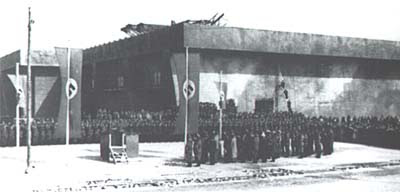Bases francesas de los U-Boote. Burdeos
Desde el otoño de 1940 la base de Burdeos fue utilizada por la flotilla italiana “Betason” y desde octubre de 1942 por la 12º Unterseebootsflotille alemana. En agosto de 1940, el almirante Doenitz se entrevistó con su colega italiano Angelo Paroma para intentar organizar una cooperación eficiente de ambas armas submarinas en el Atlántico. La Marina italiana destacó al capitán de fragata Sestini como enlace en el B.d.U. y la Kriegsmarine envió al capitán de corbeta Rösing al Estado Mayor italiano.
Los tres primeros submarinos italianos entraron en Burdeos en septiembre de 1940. Con todo, a pesar de los esfuerzos de adaptación de los comandantes y dotaciones de ambos países, el espíritu individualista de los italianos no logró adaptarse a las tácticas metódicas de los alemanes y las cosas no funcionaron como se esperaba.
La 12º Unterseebootsflotille estaba compuesta por los submarinos gigantes de aprovisionamiento con gran radio de acción, tipos IX-D2, XIV (1.932 toneladas) y X-B (2.177 toneladas). Estos buques llevaron suministros en la mar a centenares de submarinos antes de ser hundidos, la mayoría en 1943. El último de los X-B, el U-219, salió de Burdeos rumbo al Pacifico como submarino de transporte unas horas antes de que la base cayese en manos de los Aliados en agosto de 1944 y alcanzó Yakarta cuatro meses después. La Armada Imperial japonesa lo rebautizó como I-505 y continuó la lucha hasta agosto de 1945.
Inaguración del bunker a principios de 1943
También los japoneses visitaron Burdeos, en 1943 el I-8 entró en el puerto y poco más tarde regreso a sus aguas. La patrulla más larga realizada por un submarino durante la guerra sería la del U-196, mandado por el capitán de corbeta Kentrat. Este submarino regresó a Burdeos el 23 de octubre de 1943 tras permanecer 225 días en el mar.
Fuentes:
NIESTLE, A. “German U-Boot losses during World War II ” Naval Institute Press 1998
BLAIR, C. “Hitler´s U-Boat war” Random House, 1998
WYNN, K. “U-Boat operations of the Second World War” Naval Institute Press 1998
English version
Since autumn 1940 the Bordeaux base was used by the Italian fleet "Betason" and since October 1942 by the 12th German Unterseebootsflotille. In August 1940, Admiral Doenitz met with his Italian colleague Angelo writes Paroma to try to organize an efficient cooperation of both the Atlantic submarine weapons. The Italian Navy Commander stressed the link in the Sestini as BdU and the Navy sent Lieutenant Commander Rösing the Italian General Staff.
The first three Italian submarines entered Bordeaux in September 1940. However, despite efforts to adapt commanders and crews of both countries, the individualist spirit of the Italians failed to adapt to the methodical tactics of the Germans and things did not work as expected.
The 12 º Unterseebootsflotille submarines comprised the supply giant with great range, type IX-D2, XIV (1,932 tons) and XB (2,177 tons). These ships carried supplies into the sea hundreds of sunken submarines before, most in 1943. The last of the XB, the U-219 left Bordeaux heading for the Pacific submarine transport as a few hours before the base falling into the hands of the Allies in August 1944 and reached Jakarta four months later. The Japanese Imperial Navy renamed it I-505 and continued the fight until August 1945.
The building site of the bunker in autumn 1942
The Japanese visited Bordeaux in 1943, I-8 entered the port and shortly thereafter returned to its waters. The longest patrol by a submarine during the war would be that of U-196, commanded by Lieutenant Commander Kentrat. The submarine returned to Bordeaux on October 23, 1943 after spending 225 days at sea.
Sources:
NIESTLE, A. “German U-Boot losses during World War II ” Naval Institute Press 1998
BLAIR, C. “Hitler´s U-Boat war” Random House, 1998
WYNN, K. “U-Boat operations of the Second World War” Naval Institute Press 1998



No hay comentarios:
Publicar un comentario